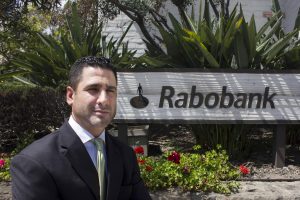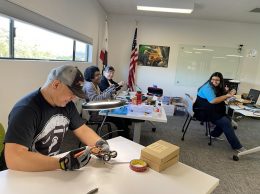Rabobank wants to be tops in ag, small biz lending
IN THIS ARTICLE
- Agribusiness Topic
- pacbiztimes Author
By pacbiztimes Friday, July 31st, 2015

Mark Borrecco, Rabobank N.A. executive vice president and chief retail banking officer, visited Santa Barbara on July 28.
After a series of branch consolidations and a strategic rethinking, Rabobank will focus its California lending on business banking, agribusiness and renewables in its core markets in the Central Valley and on the Central Coast.
The Netherlands-based banking giant has set a goal to be the global leader in food and agriculture lending as it looks to double the world’s food supply over the next 20 years while using half of the natural resources, according to Mark Borrecco, Rabobank N.A. executive vice president and chief retail banking officer.
“Over the last two years, we have been redefining who we want to be,” Borrecco told the Business Times during an interview in Santa Barbara on July 28. “From Salinas down to Ventura there’s a phenomenal opportunity, along with Fresno, Bakersfield, Roseville and the Chico markets. That’s where the food and ag opportunity is the greatest and where we could be the most relevant and successful.”
Rabobank entered California in 2002 and embarked on a string of acquisitions, including Arroyo Grande-based Mid-State Bank & Trust in 2007. Today it has more than 100 California branches and a substantial lending presence in food production, food processing and solar energy. Of Rabobank’s 8.8 million global customers, 7.6 million are based in the Netherlands.
But Rabobank’s wholesale and international retail banking income declined 7 percent in 2014 even as operating expenses fell 23 percent after significant workforce cuts. The cuts invited speculation that Rabobank would reduce or even sell its U.S. retail banking arm.
Borrecco said Rabobank has no intention of leaving California, one of the world’s most productive regions for agriculture. Instead, it wants to focus retail lending operations on businesses with annual revenue of roughly $20 million or less. So far, the strategy seems to have paid off through a modified mortgage program that makes loans of up to $2 million to small farmers who might not qualify for traditional home loans.
The Arroyo Grande-based mortgage program has grown from $300 million to more than $1 billion, he said, adding that Rabobank also expanded its SBA-guaranteed lending programs to small businesses.
“We need to be very good in small businesses in those rural communities; it’s so important to support the ag ecosystem and communities as well,” Borrecco said. “For some, it’s harder to get a mortgage because the value of the property is calculated differently. There’s so much demand for people who want to have their mortgage but can’t go the Fannie Mae route because maybe their acreage is too much or their property type doesn’t fit, and there are not a lot of banks willing to work with the farmer.”
Much of the tri-county region is fueled by agriculture — tourists and locals flock to the area’s wineries, the cut-flower industry is expanding and growers and tech firms are coming up with more efficient ways to farm. But many growers and producers lack the capital and infrastructure to scale up.
As regional banks acquire smaller banks that can’t afford to keep up with increasing regulation, Rabobank’s $15-billion-asset California unit has an opportunity to take a one-on-one approach with small borrowers, Borrecco said.
But some of the area’s economists question the growth opportunities in a volatile industry that’s squeezed by the state’s historic drought.
Meanwhile, new entrants such as San Luis Obispo-based Slow Money SLO, a peer-to-peer lending group, are creating new niches. The nonprofit fills a gap for business who may have some friend-and-family capital or crowdfunding but don’t yet qualify for a loan from a bank. Slow Money SLO founder Jeff Wade said his organization has helped food co-ops, energy bar startups, organic food storefronts, hard cider producers and food delivery services.
“We’re seeing a big gap primarily in the food business area,” said Wade, whose firm provides coaching and support to prepare small companies for the next step. “We had initially expected these would be small entrepreneurial startups, but now we’re finding more household names that are doing well but don’t have the necessarily collateral.”
Slow Money SLO has provided more than $500,000 in loans over its three years in existence, but it doesn’t necessarily see Rabobank as a competitor. To get to the next level, Wade said, he hopes to partner with Rabobank and tap its expertise.
“The differentiation for us is the food and ag ecosystem — that doesn’t just mean supporting farmers, it means supporting processors and businesses that are in the food chain,” Borrecco said.
Mike Manchak, president and CEO of the Economic Vitality Corporation in San Luis Obispo, said Rabobank may fill a niche in the expanding greenhouse grower market, which is well-suited for Nipomo’s temperate climate and affordable land.
“Greenhouse growing is increasing here and globally,” he said. “You can control water usage better and use less pesticides, but it’s very capital intensive.”
Rabobank could take advantage of the rural areas that have watched its small banks disappear, said Peter Rupert, executive director of the UC Santa Barbara Economic Forecast Project.
The Central Coast has seen a merger wave in recent years with American Riviera Bank planning to buy The Bank of Santa Barbara, Sierra Bank acquiring Santa Clara Valley Bank, Heritage Oaks snatching up Mission Community, and Union Bank acquiring Santa Barbara Bank & Trust in a deal that reshaped the regional banking landscape.
“Due to some of these compliance issues, we will see a shakeout with smaller banks and there will be more consolidation,” Rupert said. “There are fewer banks in areas where they need relationship-based banks. Rabobank can afford to be in smaller communities, do one-on-ones and maintain a larger compliance staff.”
But a heavy concentration on agribusiness has its share of risks, said Dan Hamilton, associate professor of economics at Cal Lutheran University. Smaller ag firms will likely stagnate or decline due to rising labor, regulatory and water costs, he warned.
“Ag is a tough business already in Ventura County,” Hamilton said. “It is more difficult with time to do agriculture in Ventura County due to the rising cost structure. One of the typical ways to absorb costs is consolidate and merge. The smaller guys won’t exist.”
Aside from businesses in the agriculture industry, Rabobank hopes to capitalize on renewable energy sources like rapid car charging units and solar panel installations, Borrecco said.
With its refocused strategy, Rabobank is leaving the highly competitive field of banking middle-market companies to established players such as Wells Fargo, Bank of America, Chase and Union, whose parent is Japanese banking giant MUFJ Group.
“Renewable energy, business banking, mortgage, retail, food and ag, wealth — those are the things we want to be really good at and leave all the other things for someone else,” Borrecco said.
“Sometimes in the banking business you want to be all things to all customers. That was a mistake we made,” he added. “In today’s ever-changing regulatory environment, the cost of the infrastructure to do that is too much. So you need to do fewer things and do them better.”











